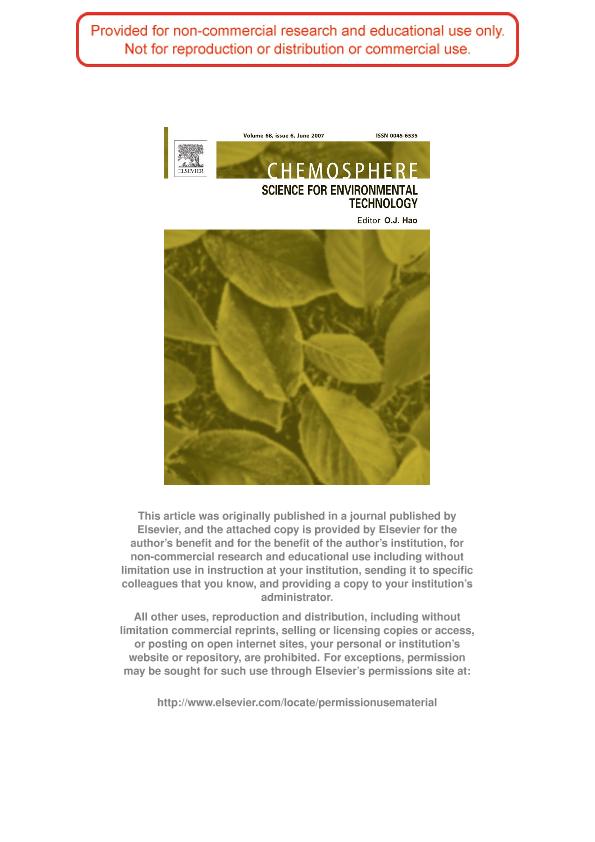Mostrar el registro sencillo del ítem
dc.contributor.author
Maine, Maria Alejandra

dc.contributor.author
Suñe, Noemi Liliana

dc.contributor.author
Hadad, Hernán Ricardo

dc.contributor.author
Sanchez, Gabriela Cristina

dc.contributor.author
Bonetto, Carlos Alberto

dc.date.available
2017-12-15T14:28:12Z
dc.date.issued
2007-06
dc.identifier.citation
Bonetto, Carlos Alberto; Sanchez, Gabriela Cristina; Hadad, Hernán Ricardo; Suñe, Noemi Liliana; Maine, Maria Alejandra; Removal efficiency of a constructed wetland for wastewater treatment according to vegetation dominance; Pergamon-Elsevier Science Ltd.; Chemosphere; 68; 6; 6-2007; 1105-1113
dc.identifier.issn
0045-6535
dc.identifier.uri
http://hdl.handle.net/11336/30734
dc.description.abstract
A free water surface wetland was built to treat wastewater containing metals (Cr, Ni and Zn) and nutrients from a tool factory in Santo Tomé, Santa Fe, Argentina. Eichhornia crassipes became dominant and covered about 80% of the surface throughout the first year, and decreased progressively until its disappearance. When water depth was lowered Typha domingensis steadily increased plant cover and attained 30% of the surface by the end of the study. While E. crassipes was dominant, the wetland retained 62% of the incoming Cr and 48% of the Ni. NO3- and NO2-, were also removed (65% and 78%, respectively), while dissolved inorganic phosphate (i-Pdiss) and NH4+ were not removed. Zn was below 50 μg l−1 in both the influent and effluent. Metal concentration in the sediments did not increase and retention was mediated through macrophytes uptake. During the period of E. crassipes decline the wetland retained 49% of the incoming Cr, 45% of Ni, 58% NO3-, 94% NO2-, 58% NH4+ and 47% i-Pdiss. Cr, Ni and Zn in the bottom sediment increased in the inlet but not in the outlet. Since T. domingensis became dominant, retention was 58% Cr, 48% Ni and 64% i-Pdiss, while 79% NO3-, 84% NO2- and 13% NH4+ were removed. Metals in the bottom sediment increased in the inlet. In spite of the significant growth of E. crassipes at the beginning, T. domingensis remained after most of the transplanted macrophytes had disappeared. Macrophyte disappearance could be related to the overall toxicity of several environmental constrains as high pH and conductivity, metal concentration, and sulphide presence.
dc.format
application/pdf
dc.language.iso
eng
dc.publisher
Pergamon-Elsevier Science Ltd.

dc.rights
info:eu-repo/semantics/openAccess
dc.rights.uri
https://creativecommons.org/licenses/by-nc-sa/2.5/ar/
dc.subject
Metals
dc.subject
Nutrients
dc.subject
Constructed Wetland
dc.subject
Effluents
dc.subject.classification
Meteorología y Ciencias Atmosféricas

dc.subject.classification
Ciencias de la Tierra y relacionadas con el Medio Ambiente

dc.subject.classification
CIENCIAS NATURALES Y EXACTAS

dc.title
Removal efficiency of a constructed wetland for wastewater treatment according to vegetation dominance
dc.type
info:eu-repo/semantics/article
dc.type
info:ar-repo/semantics/artículo
dc.type
info:eu-repo/semantics/publishedVersion
dc.date.updated
2017-10-31T13:50:40Z
dc.journal.volume
68
dc.journal.number
6
dc.journal.pagination
1105-1113
dc.journal.pais
Países Bajos

dc.journal.ciudad
Amsterdam
dc.description.fil
Fil: Maine, Maria Alejandra. Universidad Nacional del Litoral. Facultad de Ingeniería Química; Argentina. Consejo Nacional de Investigaciones Científicas y Técnicas; Argentina
dc.description.fil
Fil: Suñe, Noemi Liliana. Universidad Nacional del Litoral. Facultad de Ingeniería Química; Argentina
dc.description.fil
Fil: Hadad, Hernán Ricardo. Universidad Nacional del Litoral. Facultad de Ingeniería Química; Argentina. Consejo Nacional de Investigaciones Científicas y Técnicas; Argentina
dc.description.fil
Fil: Sanchez, Gabriela Cristina. Universidad Nacional del Litoral. Facultad de Ingeniería Química; Argentina. Consejo Nacional de Investigaciones Científicas y Técnicas; Argentina
dc.description.fil
Fil: Bonetto, Carlos Alberto. Consejo Nacional de Investigaciones Científicas y Técnicas. Centro Científico Tecnológico Conicet - La Plata. Instituto de Limnología ; Argentina
dc.journal.title
Chemosphere

dc.relation.alternativeid
info:eu-repo/semantics/altIdentifier/doi/http://dx.doi.org/10.1016/j.chemosphere.2007.01.064
dc.relation.alternativeid
info:eu-repo/semantics/altIdentifier/url/http://www.sciencedirect.com/science/article/pii/S0045653507001841
Archivos asociados
